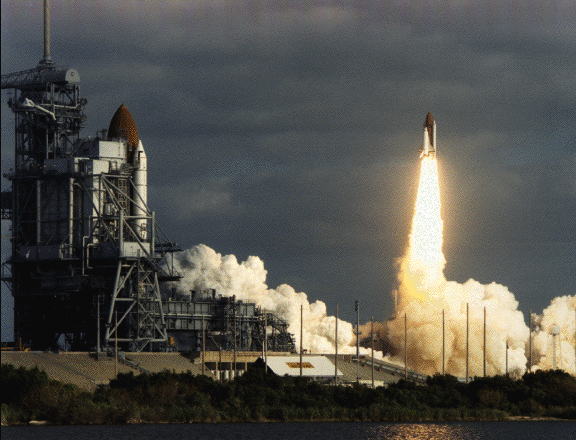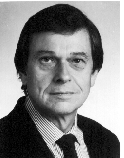



Contents:
Introduction
Science Overview
Space Experiments and Related Work
Theoretical Study
What has DCE accomplished during STS94?
Advancement of basic understanding generally is served best by
studying well-defined problems. Isolated, single droplet burning is
the simplest example of non-premixed diffusion flames with phase
change. Investigation
of the combustion of a single, isolated liquid droplet affords the
opportunity to investigate the interactions of physical and chemical
process, in an idealized and simplified geometrical
configuration.
The perceived importance of droplet vaporization/combustion
phenomena
in the liquid-fuel engine combustion and of fire hazards in handling
liquid combustibles has motivated a large number of studies on the
mechanism of droplet burning. Scientific studies of the topic first
appeared at the Fourth International Combustion Symposium in 1953,
and many review articles on the subject have been prepared.
Indeed, droplet combustion is considered a classical subject in
combustion.
The idealized model for droplet combustion considered in early works
showed
that the square of the diameter of the liquid droplet decreases
linearly with time in accordance with the so-called "d-square law".
However, simultaneous agreement of the burning-rate constant, flame
diameter, and flame temperature with isolated, single-component,
liquid-droplet combustion experiments cannot be obtained. Advances
in both asymptotic and numerical computational abilities allow more
recently analyses of droplet burning to include considerably refined
description of transport and chemical effects, particularly if the
spherically symmetric assumption can be maintained. These
improvements in theory bring closer qualitative agreement with
existing measurements. Yet, the experimental data available for
comparison, without corrections for effects of forced and/or natural
convection, remain relatively limited, particularly for conditions
resulting in transient behavior and extinction. Thus, it is
important to provide more detailed testing of the various
assumptions made in simplifying the analysis as well as to provide a
better set of experimental data for comparison with theory.
The theoretical study is paralleling the space experiments. A goal of this study is to predict the extinction diameter for fuel burning in certain ambient environments. The method is to use rate-ratio asymptotic analysis based on reduced mechanism for hydrocarbon fuel. The rate-ratio asymptotic analysis for methanol droplet combustion has essentially been done and the n-heptane analysis is still in progress.
Methanol Droplet Burning in Normal Atmospheric Air
This experiment, burning free heptane droplets in helium-oxygen mixture, identified three regimes of droplet combustion. In addition to the well-known quasisteady regime, in which the squares of both droplet and flame diameters decrease linearly with time and diffusive extinction of the flames occurs when the droplet becomes sufficiently small (so that the chemical kinetics can be related to the "extinction diameter", the droplet diameter at the time that the flame extinguishes), two previously undocumented regimes were discovered. For sufficiently large droplets, there is a regime of radiative extinction, in which energy loss by emission of infrared radiation (that accompanies the light emission which gives flames their characteristic colors) causes flame extinction during the initial stage of flame expansion, leaving a large droplet that slowly vaporizes in the hot gases left behind after combustion has ceased. At sufficiently high oxygen content, there is a regime of droplet disappearance, in which the flame persists in an outer transient region after the droplet has vaporized completely, and this flame rapidly contracts at the end of the burn, extinguishing diffusively at a nonzero flame radius. This extinction leaves behind a small fuel vapor cloud responsible for combustion inefficiency and unburnt hydrocarbon emissions in Diesel engines and other liquid-fuel combustion chambers, and the extinction flame diameter is related to the chemical kinetics relevant to this combustion.
The parameter space at one atmosphere, with oxygen mole fractions between 20% and 35% and initial droplet diameters between 0.5 mm and 4 mm, was covered with 25 good droplet burns, 9 of these from the first MSL-1 flight. These points spanned all three regimes and also revealed an ignition limit in the most dilute atmosphere (20% oxygen), in which 2 mm droplets could not be ignited and 3 mm and 4 mm droplets supported only transient flames lasting less than 2 seconds.
The parameter space at 0.5 atmospheres, with oxygen mole fractions between 25% and 40% and initial droplet diameters between 1.5 mm and 4 mm, also was covered thoroughly, with 14 good droplet burning spanning all three regimes. It was found that the 1.5 mm droplets were beyond the ignition limit in 25% and 30% oxygen.
In addition, a droplet initially 2 mm in diameter was burned in a 50% oxygen atmosphere at 0.25 atmospheres total pressure and was found to be in the regime of droplet disappearance prior to flame extinction. Analysis of this data point will provide important information related to the pressure depnedence of the chemical kinetics of heptane droplet combustion that can test future computational results.
In tests not planned initially, 4 heptane droplets were burned in spacelab cabin air at one atmosphere pressure, with initial droplet diameters between 2 mm and 4 mm. the smallest of these droplets appeared to be in the regime of droplet disappearance, while the largest appeared to exhibit radiative extinction, so that, again, all these regimes were spanned. The droplets burn considerably more slowly in air than in helium-oxygen mixtures because of the high thermal conductivity of helium, and one of the larger droplets in air burned for 20 seconds, much too longer time to be studied in earthbound facilities without influences of buoyancy. This underscores the need for these microgravity experiments to be performed in the space environment.
The results of these experiments are related to reducing air pollution, conserving liquid-fuel energy resources and improving fire safety. The radiative extinction phenomena, for example, provide information relating to fire safety within spacecraft and on earth. The measurements of droplet and flame extinction diameters, in all three regimes, provide information relevant to chemistry determining formation of pollutants much as oxides of nitrogen (smog) in flames of liquid fuels and of emissions of unburnt hydrocarbons, related to both pollution and efficiency of combustion. In addition, observations as soot production in these droplet flames were made, providing knowledge concerning particulate emissions. There are recently proposed EPA restrictions on emissions of oxides of nitrogen and particulates from Diesel engines, and heptane has been used in many scientific studies as an idealized model of Diesel fuels, so that the information generated in these experiments has a bearing on Diesel emissions. The applications ultimately concern both internal combustion engines and stationary power sources that employ liquid fuels.